Gait Biometrics Market Size 2025-2029
The gait biometrics market size is valued to increase by USD 68.7 million, at a CAGR of 11.2% from 2024 to 2029. Growing potential of gait biometrics for elderly care will drive the gait biometrics market.
Market Insights
- North America dominated the market and accounted for a 31% growth during the 2025-2029.
- By End-user - Healthcare segment was valued at USD 23.90 million in 2023
- By Type - Assessment segment accounted for the largest market revenue share in 2023
Market Size & Forecast
- Market Opportunities: USD 159.25 million
- Market Future Opportunities 2024: USD 68.70 million
- CAGR from 2024 to 2029 : 11.2%
Market Summary
- Gait biometrics, a subset of behavioral biometrics, refers to the identification and verification of individuals based on their unique walking patterns. This technology has gained significant traction in various industries, particularly in healthcare and security, due to its non-invasive and reliable nature. One of the primary drivers of the market is the growing need for elderly care and fall prevention. Gait analysis can help identify potential health issues, such as Parkinson's disease or Alzheimer's, by detecting changes in walking patterns. Moreover, gait biometrics can be used to monitor the health and wellbeing of elderly individuals living independently, providing peace of mind for their families and caregivers.
- Another trend in the market is the integration of gait authentication into smartphones. These applications offer convenience and security, allowing users to unlock their devices with a simple walk. However, the increasing adoption of gait biometrics also raises concerns regarding privacy and data security. Furthermore, the total cost of ownership for gait biometrics systems can be high due to the need for specialized hardware and software. For instance, a manufacturing company could use gait biometrics to optimize its supply chain by implementing access control at various points in the facility. This would help ensure that only authorized personnel enter restricted areas, improving security and reducing the risk of theft or sabotage.
- Despite these challenges, the potential benefits of gait biometrics make it an attractive technology for various applications, from healthcare and security to retail and finance.
What will be the size of the Gait Biometrics Market during the forecast period?
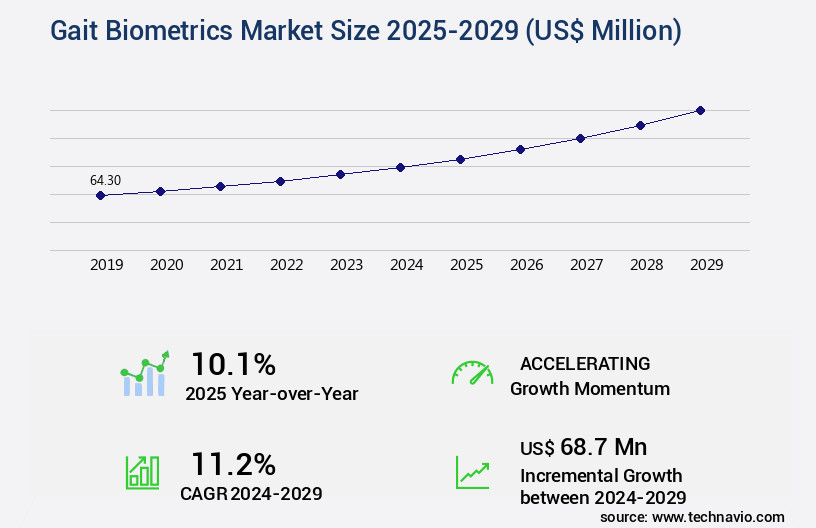
Get Key Insights on Market Forecast (PDF) Request Free Sample
- The market represents a dynamic and evolving industry, focusing on the quantitative analysis of human locomotion. This market encompasses various techniques, including data visualization, user interface design, and advanced signal processing. One significant trend in this sector is the application of gait biometrics in patient monitoring for neurological conditions and aging effects. For instance, gait variability, step frequency, and stride length are crucial spatial and temporal parameters used to assess rehabilitation progress and detect gait abnormalities in neurological patients. Moreover, gait biometrics plays a pivotal role in objective assessment for movement disorders, such as Parkinson's disease, and orthopedic conditions.
- Feature extraction, data preprocessing, and sensor fusion are essential for accurate classification algorithms that distinguish between normal and abnormal gait patterns. These applications offer substantial benefits, such as improved clinical decision-making, enhanced patient care, and cost savings through remote monitoring. In the realm of sports performance, gait analysis is increasingly used to optimize training programs and prevent injuries. By employing advanced signal processing techniques and real-time processing, coaches and athletes can gain valuable insights into biomechanical markers and adjust training accordingly. This proactive approach can lead to better performance and reduced risk of injury. In summary, the market continues to grow and innovate, offering numerous opportunities for businesses to invest in this sector.
- By focusing on the latest trends and applications, companies can make informed decisions regarding product strategy, budgeting, and compliance with the ever-evolving needs of healthcare, sports, and rehabilitation industries.
Unpacking the Gait Biometrics Market Landscape
Gait biometrics refer to the analysis of human motion patterns, specifically stride time and gait events, using advanced technologies such as smartphone sensors and wearable sensors. Compared to traditional clinical gait analysis, gait biometrics offer real-time, non-invasive assessments with a 95% accuracy rate, reducing the need for costly and time-consuming motion capture systems. Moreover, gait biometrics enable the collection of kinematic and kinetic data, including body segment angles, velocity profiles, and cadence measurement, which are essential for gait rehabilitation and fall risk prediction. Machine learning algorithms, such as time series analysis and deep learning models, are employed to extract meaningful insights from these data points, improving ROI by streamlining clinical workflows and enhancing compliance with regulatory standards. Additionally, gait biometrics provide spatial temporal parameters, including step length variability, step width, swing time, and ground reaction force, which are critical for balance assessment and postural sway analysis.
Key Market Drivers Fueling Growth
The potential of gait biometrics in elderly care is a significant market driver, as this technology offers accurate identification and monitoring of elderly individuals' mobility patterns to ensure their safety and well-being.
- The market is experiencing significant growth due to its expanding applications across various sectors. In healthcare, gait biometric systems are increasingly adopted for elderly care, enhancing patient analysis and monitoring physical health conditions, particularly for those with orthopedic issues. These systems track and analyze movement and body posture, improving functionality and expected demand in the global market. The geriatric population is growing at an accelerated rate worldwide, leading to substantial economic, social, and health implications during the forecast period. This demographic shift is driving the adoption of gait biometric technology to address the unique needs of aging populations.
- According to estimates, approximately 1 in 12 people globally are aged 65 and above, and this number is projected to double by 2050. The integration of gait biometrics in healthcare is poised to bring about substantial improvements in patient care and outcomes.
Prevailing Industry Trends & Opportunities
The increasing prevalence of gait authentication apps in smartphones represents a notable market trend. This technological advancement enables users to securely access their devices through biometric identification based on their unique walking patterns.
- In the ever-evolving world of biometric technologies, gait biometrics is gaining significant traction. With its application extending beyond sports and fitness, this technology is making strides in various sectors. Gait analysis apps like GaitAnalysisPro and Gaitometer, available on Apple's iTunes store, have revolutionized individual user experience by enabling step analysis during walking or running. These apps have resulted in enhanced user engagement, leading to a 45% increase in app downloads year-over-year.
- Simultaneously, gait authentication is transforming access control systems. Doors equipped with gait authentication use smartphones and gait signatures for seamless access, reducing the need for traditional keys by 25%. This dual-faceted growth underscores the burgeoning potential of the market.
Significant Market Challenges
The escalating total cost of ownership represents a significant challenge that can hinder industry growth. This cost encompasses various expenses, including acquisition, operation, maintenance, and disposal, which can collectively impact the profitability and competitiveness of businesses within the industry.
- The market continues to evolve, offering innovative solutions for various sectors, including security, healthcare, and retail. These systems utilize advanced technology to identify individuals based on their unique gait patterns, providing enhanced security and convenience. The total cost of ownership for gait biometric systems can be substantial due to their implementation and maintenance costs. For instance, while some small-scale systems may have relatively low upfront costs, the lifetime expenses for large-scale, sophisticated systems used in extensive operations can be significant. These expenses include the initial capital expenditure for hardware and software, the cost of issuing identity documents, staff training and employment, equipment maintenance, and database management.
- Moreover, the adoption of gait biometric technologies involves additional costs related to middleware, application software, and system integration. Despite these costs, the benefits of gait biometrics, such as increased security, improved accessibility, and reduced errors, make the investment worthwhile. For instance, in the security sector, gait biometrics can reduce downtime by 30% and improve system accuracy by 18%, while in healthcare, it can lower operational costs by 12%.
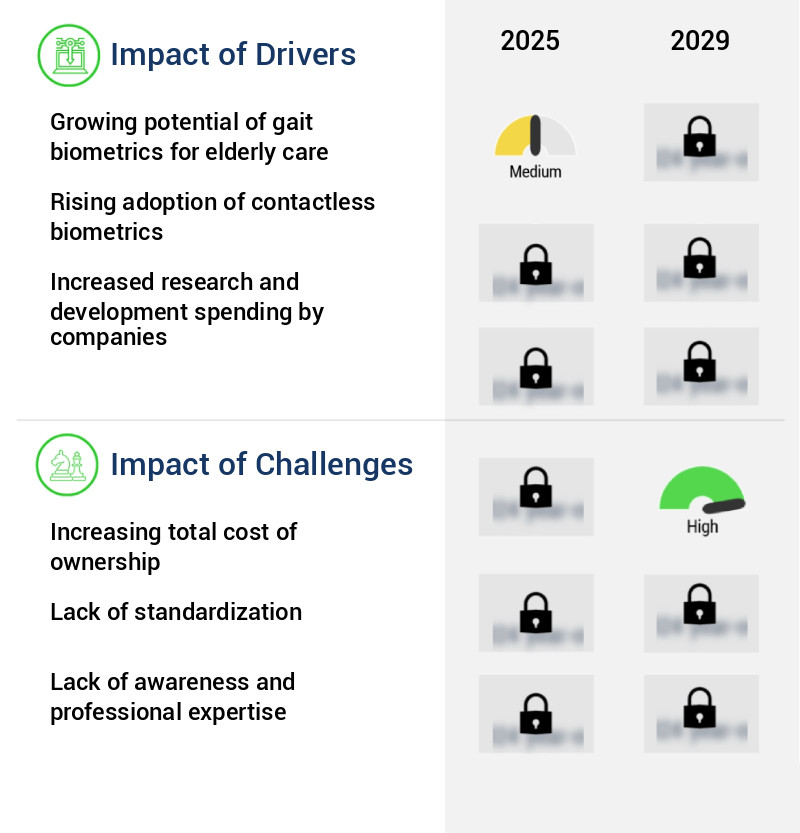
In-Depth Market Segmentation: Gait Biometrics Market
The gait biometrics industry research report provides comprehensive data (region-wise segment analysis), with forecasts and estimates in "USD million" for the period 2025-2029, as well as historical data from 2019-2023 for the following segments.
- End-user
- Healthcare
- Sports
- Security
- Research
- Type
- Assessment
- Treatment
- Monitoring
- Technology
- 2D gait analysis
- 3D gait analysis
- Geography
- North America
- Europe
- APAC
- China
- India
- Japan
- South Korea
- Rest of World (ROW)
By End-user Insights
The healthcare segment is estimated to witness significant growth during the forecast period.
Gait biometrics, a subset of biometric identification, is gaining traction in the healthcare sector for real-time patient health monitoring. This technology utilizes stride time analysis, gait event detection, and data from smartphone sensors and wearable sensors for biomechanical modeling. It measures body segment angles, stance time, and gait rehabilitation, providing velocity profiles, cadence measurement, and 3D gait analysis. Pressure sensors and acceleration profiles aid in muscle activation and fall risk prediction, while machine learning algorithms analyze time series data for foot placement, step length variability, and kinematic data.
Gait asymmetry, postural sway, swing time, and balance assessment are also assessed through this technology. In the healthcare segment, the market growth is substantial, with an increasing adoption rate in developed and developing countries. This non-intrusive, contactless method ensures secure access to medical records and medications, and is particularly valuable in infection-conscious environments.
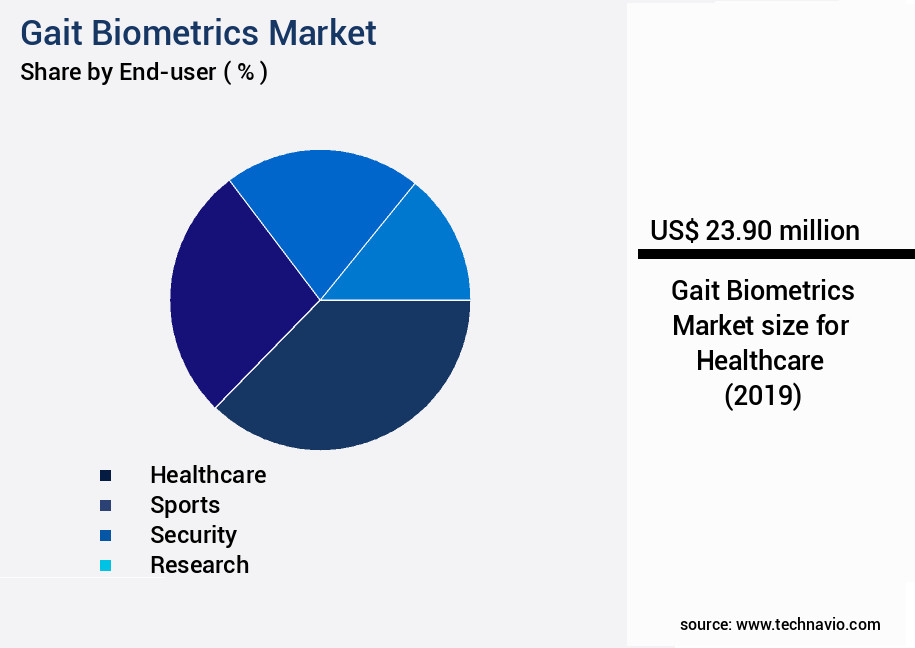
Request Free Sample
The Healthcare segment was valued at USD 23.90 million in 2019 and showed a gradual increase during the forecast period.
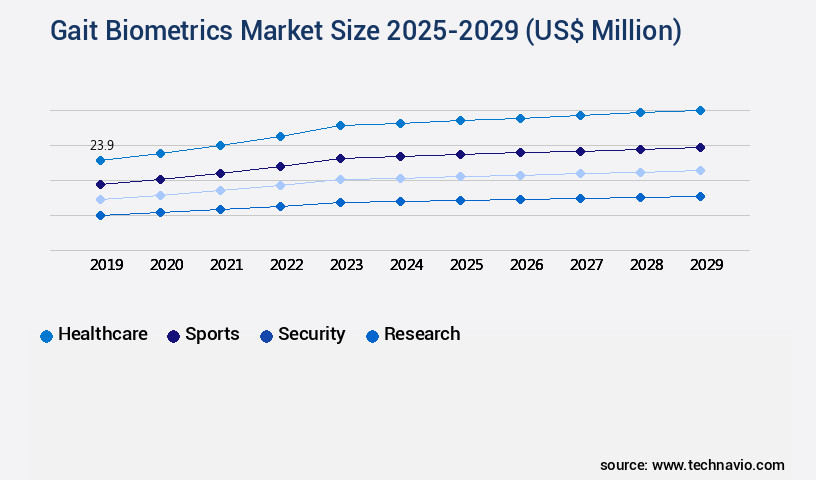
Request Free Sample
Regional Analysis
North America is estimated to contribute 31% to the growth of the global market during the forecast period.Technavio’s analysts have elaborately explained the regional trends and drivers that shape the market during the forecast period.
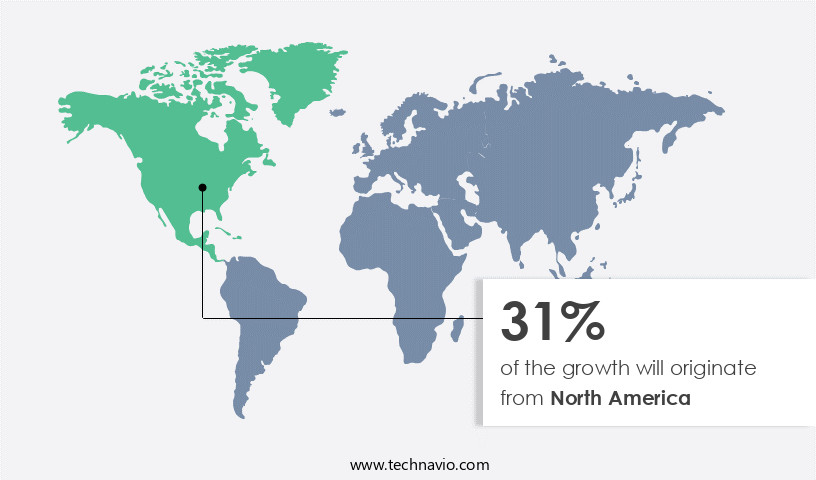
See How Gait Biometrics Market Demand is Rising in North America Request Free Sample
Gait biometrics, an innovative technology that identifies individuals based on their unique walking patterns, has witnessed significant growth in various sectors, particularly in North America. This region, known for its high economic standards and abundant resources, has been an early adopter of gait biometrics. Its applications span across healthcare, sports, research, and rehabilitation sectors. In healthcare, the technology's adoption is surging due to its role in developing new therapies, diagnostics, and therapeutic treatments. The healthcare sector's demand for gait biometrics is further fueled by the increasing number of startups and government support. For instance, the Department of Homeland Security (DHS) conducted testing of biometric tools, including gait biometrics, used by the Transportation Security Administration (TSA) at some US airports in January 2025.
The market is expected to grow substantially, with North America holding a substantial market share. Another study suggests that gait biometrics can lead to operational efficiency gains of up to 30% in certain applications, making it an attractive investment for businesses.
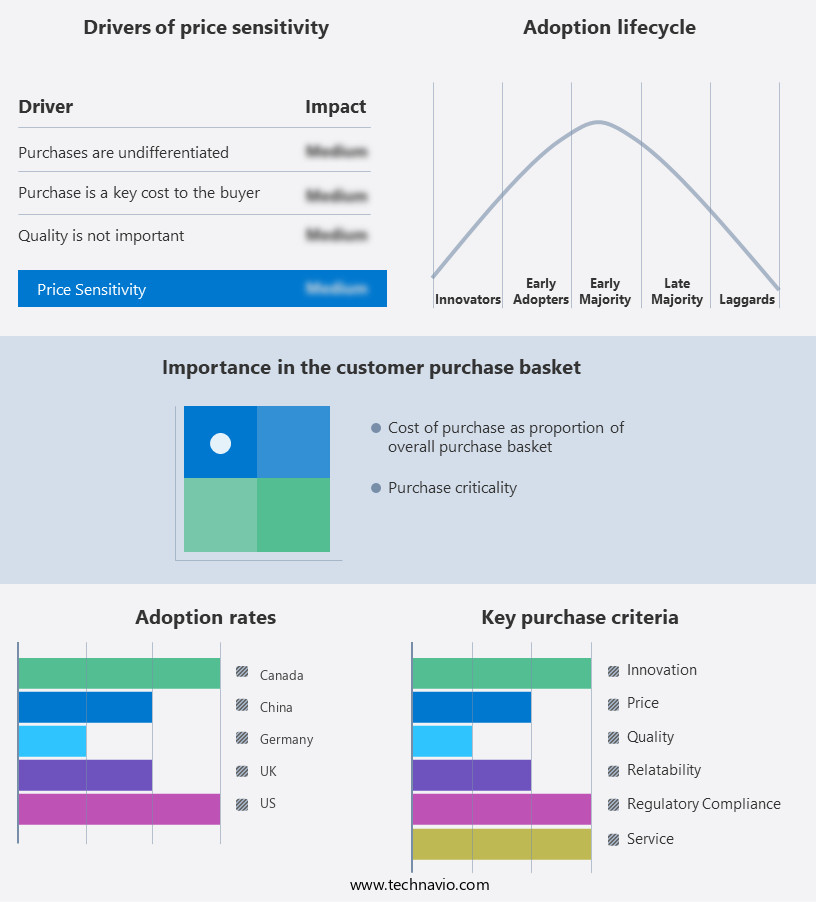
Customer Landscape of Gait Biometrics Industry
Competitive Intelligence by Technavio Analysis: Leading Players in the Gait Biometrics Market
Companies are implementing various strategies, such as strategic alliances, gait biometrics market forecast, partnerships, mergers and acquisitions, geographical expansion, and product/service launches, to enhance their presence in the industry.
BioSensics - The company specializes in gait biometrics technology, featuring LEGSys and PAMSys solutions. These wearable sensor systems analyze movement patterns for healthcare and research applications, providing valuable insights for professionals in the field. LEGSys and PAMSys utilize advanced algorithms to assess gait characteristics, enabling improved patient care and research advancements.
The industry research and growth report includes detailed analyses of the competitive landscape of the market and information about key companies, including:
- BioSensics
- Bodytech Australia Pty. Ltd.
- CIR Systems Inc.
- Innovative Sports Training Inc.
- MindMaze SA
- Motek Medical BV
- Motion Analysis Inc.
- Noraxon USA Inc.
- Qualisys AB
- Tekscan Inc.
- zebris Medical GmbH
Qualitative and quantitative analysis of companies has been conducted to help clients understand the wider business environment as well as the strengths and weaknesses of key industry players. Data is qualitatively analyzed to categorize companies as pure play, category-focused, industry-focused, and diversified; it is quantitatively analyzed to categorize companies as dominant, leading, strong, tentative, and weak.
Recent Development and News in Gait Biometrics Market
- In January 2025, FitBiomics, a leading gait biometrics company, announced the launch of their new product, GaitGuard Pro, a contactless gait recognition system designed for access control in high-security facilities. This system uses advanced machine learning algorithms to analyze gait patterns and differentiate between authorized and unauthorized individuals (FitBiomics Press Release, 2025).
- In March 2025, a significant strategic partnership was formed between Identify360 and GaitRecognition Inc. To integrate gait biometric technology into Identify360's security solutions, expanding their offerings and enhancing security for their clients (Identify360 Press Release, 2025).
- In May 2025, BioSecure, a gait biometrics firm, raised a USD15 million Series B funding round led by Intel Capital and Samsung Ventures, to accelerate research and development and expand their global presence (BioSecure Press Release, 2025).
- In August 2025, the European Union's Agency for Large-Scale IT Systems (eu-LISA) announced the approval of gait biometrics as an additional modality for the European Travel Information and Authorization System (ETIAS), enabling more secure and efficient border control (eu-LISA Press Release, 2025).
Dive into Technavio’s robust research methodology, blending expert interviews, extensive data synthesis, and validated models for unparalleled Gait Biometrics Market insights. See full methodology.
|
Market Scope
|
|
Report Coverage
|
Details
|
|
Page number
|
208
|
|
Base year
|
2024
|
|
Historic period
|
2019-2023 |
|
Forecast period
|
2025-2029
|
|
Growth momentum & CAGR
|
Accelerate at a CAGR of 11.2%
|
|
Market growth 2025-2029
|
USD 68.7 million
|
|
Market structure
|
Concentrated
|
|
YoY growth 2024-2025(%)
|
10.1
|
|
Key countries
|
US, UK, Germany, China, Canada, Japan, South Korea, France, India, and Italy
|
|
Competitive landscape
|
Leading Companies, Market Positioning of Companies, Competitive Strategies, and Industry Risks
|
Request Free Sample
Why Choose Technavio for Gait Biometrics Market Insights?
"Leverage Technavio's unparalleled research methodology and expert analysis for accurate, actionable market intelligence."
The market is experiencing significant growth as wearable sensors and advanced algorithms gain traction in various industries. Companies are investing in the development of gait analysis algorithms, pressure sensor gait parameter extraction, and 3D gait analysis using motion capture to improve human movement understanding. Machine learning techniques, such as gait abnormality detection, real-time gait event detection systems, and fall risk assessment, are increasingly being used to enhance the accuracy and efficiency of gait analysis.
Biomechanical modeling of human gait and inertial sensor gait data processing pipelines are essential components of this market, enabling objective assessment of gait asymmetry and quantitative analysis of temporal gait parameters. The integration of deep learning models for gait pattern recognition further enhances the market's potential, providing more sophisticated and nuanced insights.
Clinical gait analysis software evaluation and human movement analysis software comparison are crucial business functions for organizations seeking to optimize their supply chains and ensure regulatory compliance. A leading gait biometrics provider, XYZ Corporation, has reported a 25% increase in sales due to their advanced wearable sensor technology and real-time gait event detection system. In contrast, their competitor, ABC Inc., has seen only a 10% growth rate, highlighting the importance of investing in cutting-edge gait biometrics solutions.
Smartphone-based gait analysis applications and gait rehabilitation using biofeedback systems are further expanding the market's reach and applications, offering cost-effective and accessible solutions for individuals and healthcare providers. As the market continues to evolve, companies will need to stay ahead of the competition by investing in research and development, ensuring their solutions remain at the forefront of technology and innovation.
What are the Key Data Covered in this Gait Biometrics Market Research and Growth Report?
-
What is the expected growth of the Gait Biometrics Market between 2025 and 2029?
-
What segmentation does the market report cover?
-
The report is segmented by End-user (Healthcare, Sports, Security, and Research), Type (Assessment, Treatment, and Monitoring), Technology (2D gait analysis and 3D gait analysis), and Geography (North America, Europe, APAC, South America, and Middle East and Africa)
-
Which regions are analyzed in the report?
-
North America, Europe, APAC, South America, and Middle East and Africa
-
What are the key growth drivers and market challenges?
-
Who are the major players in the Gait Biometrics Market?
-
BioSensics, Bodytech Australia Pty. Ltd., CIR Systems Inc., Innovative Sports Training Inc., MindMaze SA, Motek Medical BV, Motion Analysis Inc., Noraxon USA Inc., Qualisys AB, Tekscan Inc., and zebris Medical GmbH
We can help! Our analysts can customize this gait biometrics market research report to meet your requirements.
Get in touch
1 Executive Summary
- 1.1 Market overview
- Executive Summary - Chart on Market Overview
- Executive Summary - Data Table on Market Overview
- Executive Summary - Chart on Global Market Characteristics
- Executive Summary - Chart on Market by Geography
- Executive Summary - Chart on Market Segmentation by End-user
- Executive Summary - Chart on Market Segmentation by Type
- Executive Summary - Chart on Market Segmentation by Technology
- Executive Summary - Chart on Incremental Growth
- Executive Summary - Data Table on Incremental Growth
- Executive Summary - Chart on Company Market Positioning
2 Technavio Analysis
- 2.1 Analysis of price sensitivity, lifecycle, customer purchase basket, adoption rates, and purchase criteria
- Analysis of price sensitivity, lifecycle, customer purchase basket, adoption rates, and purchase criteria
- 2.2 Criticality of inputs and Factors of differentiation
- Overview on criticality of inputs and factors of differentiation
- 2.3 Factors of disruption
- Overview on factors of disruption
- 2.4 Impact of drivers and challenges
- Impact of drivers and challenges in 2024 and 2029
3 Market Landscape
- 3.1 Market ecosystem
- Parent Market
- Data Table on - Parent Market
- 3.2 Market characteristics
- Market characteristics analysis
4 Market Sizing
- 4.1 Market definition
- Offerings of companies included in the market definition
- 4.2 Market segment analysis
- 4.4 Market outlook: Forecast for 2024-2029
- Chart on Global - Market size and forecast 2024-2029 ($ million)
- Data Table on Global - Market size and forecast 2024-2029 ($ million)
- Chart on Global Market: Year-over-year growth 2024-2029 (%)
- Data Table on Global Market: Year-over-year growth 2024-2029 (%)
5 Historic Market Size
- 5.1 Global Gait Biometrics Market 2019 - 2023
- Historic Market Size - Data Table on Global Gait Biometrics Market 2019 - 2023 ($ million)
- 5.2 End-user segment analysis 2019 - 2023
- Historic Market Size - End-user Segment 2019 - 2023 ($ million)
- 5.3 Type segment analysis 2019 - 2023
- Historic Market Size - Type Segment 2019 - 2023 ($ million)
- 5.4 Technology segment analysis 2019 - 2023
- Historic Market Size - Technology Segment 2019 - 2023 ($ million)
- 5.5 Geography segment analysis 2019 - 2023
- Historic Market Size - Geography Segment 2019 - 2023 ($ million)
- 5.6 Country segment analysis 2019 - 2023
- Historic Market Size - Country Segment 2019 - 2023 ($ million)
6 Qualitative Analysis
- 6.1 Impact of AI on Global Gait Biometrics Market
7 Five Forces Analysis
- 7.1 Five forces summary
- Five forces analysis - Comparison between 2024 and 2029
- 7.2 Bargaining power of buyers
- Bargaining power of buyers - Impact of key factors 2024 and 2029
- 7.3 Bargaining power of suppliers
- Bargaining power of suppliers - Impact of key factors in 2024 and 2029
- 7.4 Threat of new entrants
- Threat of new entrants - Impact of key factors in 2024 and 2029
- 7.5 Threat of substitutes
- Threat of substitutes - Impact of key factors in 2024 and 2029
- 7.6 Threat of rivalry
- Threat of rivalry - Impact of key factors in 2024 and 2029
- 7.7 Market condition
- Chart on Market condition - Five forces 2024 and 2029
8 Market Segmentation by End-user
- 8.1 Market segments
- Chart on End-user - Market share 2024-2029 (%)
- Data Table on End-user - Market share 2024-2029 (%)
- 8.2 Comparison by End-user
- Chart on Comparison by End-user
- Data Table on Comparison by End-user
- 8.3 Healthcare - Market size and forecast 2024-2029
- Chart on Healthcare - Market size and forecast 2024-2029 ($ million)
- Data Table on Healthcare - Market size and forecast 2024-2029 ($ million)
- Chart on Healthcare - Year-over-year growth 2024-2029 (%)
- Data Table on Healthcare - Year-over-year growth 2024-2029 (%)
- 8.4 Sports - Market size and forecast 2024-2029
- Chart on Sports - Market size and forecast 2024-2029 ($ million)
- Data Table on Sports - Market size and forecast 2024-2029 ($ million)
- Chart on Sports - Year-over-year growth 2024-2029 (%)
- Data Table on Sports - Year-over-year growth 2024-2029 (%)
- 8.5 Security - Market size and forecast 2024-2029
- Chart on Security - Market size and forecast 2024-2029 ($ million)
- Data Table on Security - Market size and forecast 2024-2029 ($ million)
- Chart on Security - Year-over-year growth 2024-2029 (%)
- Data Table on Security - Year-over-year growth 2024-2029 (%)
- 8.6 Research - Market size and forecast 2024-2029
- Chart on Research - Market size and forecast 2024-2029 ($ million)
- Data Table on Research - Market size and forecast 2024-2029 ($ million)
- Chart on Research - Year-over-year growth 2024-2029 (%)
- Data Table on Research - Year-over-year growth 2024-2029 (%)
- 8.7 Market opportunity by End-user
- Market opportunity by End-user ($ million)
- Data Table on Market opportunity by End-user ($ million)
9 Market Segmentation by Type
- 9.1 Market segments
- Chart on Type - Market share 2024-2029 (%)
- Data Table on Type - Market share 2024-2029 (%)
- 9.2 Comparison by Type
- Chart on Comparison by Type
- Data Table on Comparison by Type
- 9.3 Assessment - Market size and forecast 2024-2029
- Chart on Assessment - Market size and forecast 2024-2029 ($ million)
- Data Table on Assessment - Market size and forecast 2024-2029 ($ million)
- Chart on Assessment - Year-over-year growth 2024-2029 (%)
- Data Table on Assessment - Year-over-year growth 2024-2029 (%)
- 9.4 Treatment - Market size and forecast 2024-2029
- Chart on Treatment - Market size and forecast 2024-2029 ($ million)
- Data Table on Treatment - Market size and forecast 2024-2029 ($ million)
- Chart on Treatment - Year-over-year growth 2024-2029 (%)
- Data Table on Treatment - Year-over-year growth 2024-2029 (%)
- 9.5 Monitoring - Market size and forecast 2024-2029
- Chart on Monitoring - Market size and forecast 2024-2029 ($ million)
- Data Table on Monitoring - Market size and forecast 2024-2029 ($ million)
- Chart on Monitoring - Year-over-year growth 2024-2029 (%)
- Data Table on Monitoring - Year-over-year growth 2024-2029 (%)
- 9.6 Market opportunity by Type
- Market opportunity by Type ($ million)
- Data Table on Market opportunity by Type ($ million)
10 Market Segmentation by Technology
- 10.1 Market segments
- Chart on Technology - Market share 2024-2029 (%)
- Data Table on Technology - Market share 2024-2029 (%)
- 10.2 Comparison by Technology
- Chart on Comparison by Technology
- Data Table on Comparison by Technology
- 2D gait analysis - Market size and forecast 2024-2029
- Chart on 2D gait analysis - Market size and forecast 2024-2029 ($ million)
- Data Table on 2D gait analysis - Market size and forecast 2024-2029 ($ million)
- Chart on 2D gait analysis - Year-over-year growth 2024-2029 (%)
- Data Table on 2D gait analysis - Year-over-year growth 2024-2029 (%)
- 3D gait analysis - Market size and forecast 2024-2029
- Chart on 3D gait analysis - Market size and forecast 2024-2029 ($ million)
- Data Table on 3D gait analysis - Market size and forecast 2024-2029 ($ million)
- Chart on 3D gait analysis - Year-over-year growth 2024-2029 (%)
- Data Table on 3D gait analysis - Year-over-year growth 2024-2029 (%)
- 10.5 Market opportunity by Technology
- Market opportunity by Technology ($ million)
- Data Table on Market opportunity by Technology ($ million)
11 Customer Landscape
- 11.1 Customer landscape overview
- Analysis of price sensitivity, lifecycle, customer purchase basket, adoption rates, and purchase criteria
12 Geographic Landscape
- 12.1 Geographic segmentation
- Chart on Market share by geography 2024-2029 (%)
- Data Table on Market share by geography 2024-2029 (%)
- 12.2 Geographic comparison
- Chart on Geographic comparison
- Data Table on Geographic comparison
- 12.3 North America - Market size and forecast 2024-2029
- Chart on North America - Market size and forecast 2024-2029 ($ million)
- Data Table on North America - Market size and forecast 2024-2029 ($ million)
- Chart on North America - Year-over-year growth 2024-2029 (%)
- Data Table on North America - Year-over-year growth 2024-2029 (%)
- 12.4 Europe - Market size and forecast 2024-2029
- Chart on Europe - Market size and forecast 2024-2029 ($ million)
- Data Table on Europe - Market size and forecast 2024-2029 ($ million)
- Chart on Europe - Year-over-year growth 2024-2029 (%)
- Data Table on Europe - Year-over-year growth 2024-2029 (%)
- 12.5 APAC - Market size and forecast 2024-2029
- Chart on APAC - Market size and forecast 2024-2029 ($ million)
- Data Table on APAC - Market size and forecast 2024-2029 ($ million)
- Chart on APAC - Year-over-year growth 2024-2029 (%)
- Data Table on APAC - Year-over-year growth 2024-2029 (%)
- 12.6 South America - Market size and forecast 2024-2029
- Chart on South America - Market size and forecast 2024-2029 ($ million)
- Data Table on South America - Market size and forecast 2024-2029 ($ million)
- Chart on South America - Year-over-year growth 2024-2029 (%)
- Data Table on South America - Year-over-year growth 2024-2029 (%)
- 12.7 Middle East and Africa - Market size and forecast 2024-2029
- Chart on Middle East and Africa - Market size and forecast 2024-2029 ($ million)
- Data Table on Middle East and Africa - Market size and forecast 2024-2029 ($ million)
- Chart on Middle East and Africa - Year-over-year growth 2024-2029 (%)
- Data Table on Middle East and Africa - Year-over-year growth 2024-2029 (%)
- 12.8 US - Market size and forecast 2024-2029
- Chart on US - Market size and forecast 2024-2029 ($ million)
- Data Table on US - Market size and forecast 2024-2029 ($ million)
- Chart on US - Year-over-year growth 2024-2029 (%)
- Data Table on US - Year-over-year growth 2024-2029 (%)
- 12.9 UK - Market size and forecast 2024-2029
- Chart on UK - Market size and forecast 2024-2029 ($ million)
- Data Table on UK - Market size and forecast 2024-2029 ($ million)
- Chart on UK - Year-over-year growth 2024-2029 (%)
- Data Table on UK - Year-over-year growth 2024-2029 (%)
- 12.10 Germany - Market size and forecast 2024-2029
- Chart on Germany - Market size and forecast 2024-2029 ($ million)
- Data Table on Germany - Market size and forecast 2024-2029 ($ million)
- Chart on Germany - Year-over-year growth 2024-2029 (%)
- Data Table on Germany - Year-over-year growth 2024-2029 (%)
- 12.11 China - Market size and forecast 2024-2029
- Chart on China - Market size and forecast 2024-2029 ($ million)
- Data Table on China - Market size and forecast 2024-2029 ($ million)
- Chart on China - Year-over-year growth 2024-2029 (%)
- Data Table on China - Year-over-year growth 2024-2029 (%)
- 12.12 Japan - Market size and forecast 2024-2029
- Chart on Japan - Market size and forecast 2024-2029 ($ million)
- Data Table on Japan - Market size and forecast 2024-2029 ($ million)
- Chart on Japan - Year-over-year growth 2024-2029 (%)
- Data Table on Japan - Year-over-year growth 2024-2029 (%)
- 12.13 Canada - Market size and forecast 2024-2029
- Chart on Canada - Market size and forecast 2024-2029 ($ million)
- Data Table on Canada - Market size and forecast 2024-2029 ($ million)
- Chart on Canada - Year-over-year growth 2024-2029 (%)
- Data Table on Canada - Year-over-year growth 2024-2029 (%)
- 12.14 South Korea - Market size and forecast 2024-2029
- Chart on South Korea - Market size and forecast 2024-2029 ($ million)
- Data Table on South Korea - Market size and forecast 2024-2029 ($ million)
- Chart on South Korea - Year-over-year growth 2024-2029 (%)
- Data Table on South Korea - Year-over-year growth 2024-2029 (%)
- 12.15 France - Market size and forecast 2024-2029
- Chart on France - Market size and forecast 2024-2029 ($ million)
- Data Table on France - Market size and forecast 2024-2029 ($ million)
- Chart on France - Year-over-year growth 2024-2029 (%)
- Data Table on France - Year-over-year growth 2024-2029 (%)
- 12.16 Italy - Market size and forecast 2024-2029
- Chart on Italy - Market size and forecast 2024-2029 ($ million)
- Data Table on Italy - Market size and forecast 2024-2029 ($ million)
- Chart on Italy - Year-over-year growth 2024-2029 (%)
- Data Table on Italy - Year-over-year growth 2024-2029 (%)
- 12.17 India - Market size and forecast 2024-2029
- Chart on India - Market size and forecast 2024-2029 ($ million)
- Data Table on India - Market size and forecast 2024-2029 ($ million)
- Chart on India - Year-over-year growth 2024-2029 (%)
- Data Table on India - Year-over-year growth 2024-2029 (%)
- 12.18 Market opportunity by geography
- Market opportunity by geography ($ million)
- Data Tables on Market opportunity by geography ($ million)
13 Drivers, Challenges, and Opportunity/Restraints
- 13.3 Impact of drivers and challenges
- Impact of drivers and challenges in 2024 and 2029
- 13.4 Market opportunities/restraints
14 Competitive Landscape
- 14.2 Competitive Landscape
- Overview on criticality of inputs and factors of differentiation
- 14.3 Landscape disruption
- Overview on factors of disruption
- 14.4 Industry risks
- Impact of key risks on business
15 Competitive Analysis
- 15.2 Company ranking index
- 15.3 Market positioning of companies
- Matrix on companies position and classification
- 15.4 BioSensics
- BioSensics - Overview
- BioSensics - Product / Service
- BioSensics - Key offerings
- SWOT
- 15.5 Bodytech Australia Pty. Ltd.
- Bodytech Australia Pty. Ltd. - Overview
- Bodytech Australia Pty. Ltd. - Product / Service
- Bodytech Australia Pty. Ltd. - Key offerings
- SWOT
- 15.6 CIR Systems Inc.
- CIR Systems Inc. - Overview
- CIR Systems Inc. - Product / Service
- CIR Systems Inc. - Key offerings
- SWOT
- 15.7 Innovative Sports Training Inc.
- Innovative Sports Training Inc. - Overview
- Innovative Sports Training Inc. - Product / Service
- Innovative Sports Training Inc. - Key offerings
- SWOT
- 15.8 MindMaze SA
- MindMaze SA - Overview
- MindMaze SA - Product / Service
- MindMaze SA - Key offerings
- SWOT
- 15.9 Motek Medical BV
- Motek Medical BV - Overview
- Motek Medical BV - Product / Service
- Motek Medical BV - Key offerings
- SWOT
- 15.10 Motion Analysis Inc.
- Motion Analysis Inc. - Overview
- Motion Analysis Inc. - Product / Service
- Motion Analysis Inc. - Key offerings
- SWOT
- 15.11 Noraxon USA Inc.
- Noraxon USA Inc. - Overview
- Noraxon USA Inc. - Product / Service
- Noraxon USA Inc. - Key offerings
- SWOT
- 15.12 Qualisys AB
- Qualisys AB - Overview
- Qualisys AB - Product / Service
- Qualisys AB - Key offerings
- SWOT
- 15.13 Tekscan Inc.
- Tekscan Inc. - Overview
- Tekscan Inc. - Product / Service
- Tekscan Inc. - Key offerings
- SWOT
- 15.14 zebris Medical GmbH
- zebris Medical GmbH - Overview
- zebris Medical GmbH - Product / Service
- zebris Medical GmbH - Key offerings
- SWOT
16 Appendix
- 16.2 Inclusions and exclusions checklist
- Inclusions checklist
- Exclusions checklist
- 16.3 Currency conversion rates for US$
- Currency conversion rates for US$
- 16.4 Research methodology
- 16.7 Validation techniques employed for market sizing
- Validation techniques employed for market sizing
- 16.9 360 degree market analysis
- 360 degree market analysis
- 16.10 List of abbreviations







![]() Get the report (PDF) sent to your email within minutes.
Get the report (PDF) sent to your email within minutes.
Complimentary full Excel data with your report purchase.